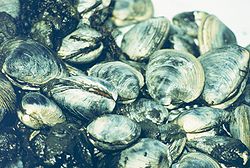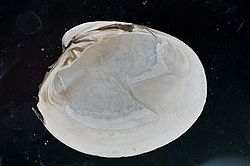Hard clam
| Hard clam |
|---|

|
| Scientific Classification |
|
| Binomial Name |
|
Mercenaria mercenaria |
| Mercenaria mercenaria clam shell |
The Hard Clam is a species of clam known by the scientific name Mercenaria mercenaria, which is perhaps best known as a popular food clam. They are also known as the northern quahog or simply the quahog in New England. They were originally found in St. Lawrence all the way up to Florida, but they have been distributed all over the place to different countries and different states in the United States.
Anatomy
External Anatomy
The hard clam has to Rough valves. The valves are held together by a hinge that clamps the valves closed when it is necessary to protect the internal parts and opens when it is ready to eat. Each of the two valves are identical in shape which in other clams is not the case. Each valve has its own umbo (the rounded or pointed extremity of a bivalve shell), which is the oldest part of the shell. The Hard Clam is also bilaterally symmetrical. The hinge has teeth like objects that it uses as alignment when closing the Valves.[1]
Internal Anatomy
The Hard clam has a Mantle Skirt that is attached along the inside of the shell. This is a thin piece of tissue. The pallial muscles hold the skirt to the shell. Between the Mantle Skirt is the Mantle Cavity. The Mantle Cavity is divided into two sections, the Inhalant Chamber and the Exhalant Chamber.[2] The Exhalant Chamber is a lot smaller than the Inhalant Chamber. Both are separated by the gills. Next to the Gills is the Foot. The Mantle of the Hard Clam has Four folds were most other Clams have only Three. The Hard Clam has two kidneys which are part of the excretory system they are located on the Floor of the clam. The digestive system of the Hard clam includes the Mouth, Esophagus, Stomach, Digestive Ceca, Midgut, Rectum, and Anus
Reproduction
Sexual reproduction in hard clams happens annually. The hard clam forms gametes (sperm and egg) through a process known as gametogenesis. During this process, the hard Clam also increases the thickness of the follicle walls.[3] The gametes of the female are called ova, while the gametes of the male are sperm. Once the germinal ducts are full with the mature gametes the clams are ready for spawning. Fertilization happens in the water column. The larvae start to form with in twenty four hours of fertilization and are able to swim freely to eat. Within sixteen days the mantle of the larvae starts to form two hard shells on the outside layer with a hinge and an umbo. Once the shell has formed they anchor themselves to the bottom floor of the ocean.
Ecology
The Hard clam ranges from Gulf of St. Lawrence Canada to New Mexico area. People have introduced them to most of the United States and Other countries. They are found in most lagoons around or along the coast. [4] They are also on muddy bottoms of oceans and lagoons. They like depths of up to 15m. They are what’s called suspension feeders.[5] This species is primarily controlled in there juvenile stages do to predators.
About
This Clam was originally found in St. Lawrence to the bay of Florida. It was introduced to Humboldt Bay, California, Washington and Puerto Rico. It has also been introduced to Britain. [6] Native Americans used to harvest them and use them to eat and as tools. They also used the shells of the Hard Clam to make necklaces. The shells were used as the decorations of the necklaces. The Hard clam then became part of the New England Culture in the 1981. It was used to make Clam Chowder. The Hard Clam has been used in trade for a long time.[7]
References
- Biological Report of Hard Clam Arnold G. Eversole,Department o f Aquaculture,Fisheries and Wildlife,August 1987.
- Mercenaria mercenaria - Quahog with notes on Tapes japonicus Richard Fox, Invertebrate Anatomy OnLine. May, 24, 2007.
- Biology and Culture of the Northern Quahog Clam Wendell J. Lorio and Sandra Malone, Southern Regional Aquaculture Center, February 1995.
- and Agriculture Organization of the United NationsFisheries andAquaculture Department, 2010.
- Hard clamsJanuary 2005,
- Quahogs in eastern North America: Part I, biology, ecology, and historical uses Clyde L. MacKenzie, Jr., Allan Morrison, David L. Taylor, Victor G. Burrell, Jr., William S. Arnold, Armando T. Wakida-Kusunoki, Marine Fisheries Review, Spring, 2002


